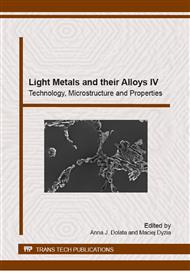p.71
p.77
p.83
p.89
p.99
p.105
p.115
p.125
p.131
Magnesium Alloy AZ31 - Short Carbon Fiber Composite Obtained by Pressure Die Casting
Abstract:
The application of short carbon fibers in magnesium alloy AZ31 matrix composite fabrication by cold chamber pressure die casting was presented. A technological procedure of small-sized and complex-shaped composite casts manufacturing was shown. The microstructure of the composite was characterized as well as its mechanical properties, friction coefficient and wear resistance. The application of mechanical stirring of melted AZ31 alloy with short fibers and then AZ31-Cf suspension pressure die casting ensured obtaining casts with the reinforcing phase correctly distributed and well bonded with the matrix. Comparision of the AZ31-Cf composite with the AZ31 alloy properties, cast in the same conditions, revealed a considerable increase in bending strength and hardness, and some improvement of ductility and sliding friction parameters as a result of short carbon fibers application.
Info:
Periodical:
Pages:
115-122
Citation:
Online since:
April 2015
Authors:
Price:
Сopyright:
© 2015 Trans Tech Publications Ltd. All Rights Reserved
Share:
Citation:


